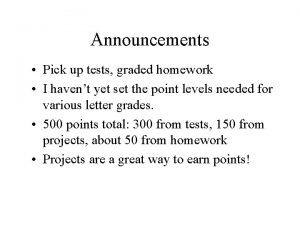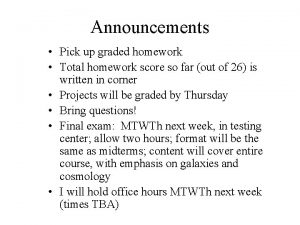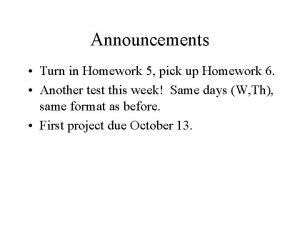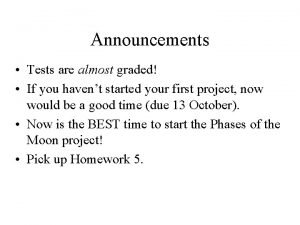Announcements Pick up graded homework projects tests still












- Slides: 12

Announcements • Pick up graded homework (projects, tests still in progress) • Transit of Mercury (crossing in front of Sun), this afternoon, roughly noon-5: 00. We’ll have telescopes set up at observatory for viewing (weather permitting).

Neutron Stars 8 November 2006

Today: • Final days of a massive star • Neutron stars and how they form • What we observe: Pulsars

Neutron Star Formation proton electron neutrino • When the mass of the iron core exceeds the Chandrasekhar limit it implodes, again converting gravitational energy into thermal energy. • As the hot material is crushed to nuclear density, protons and electrons combine to form neutrons. • The result is a “neutron star”: a ball of neutrons heavier than our sun, roughly 30 kilometers across (first predicted in 1932). • The left-over energy blows the rest of the star outward in a type-II supernova explosion.

Neutrinos from Supernova 1987 a

Size of a neutron star

The discovery of pulsars (1967) Radio antenna array, near Cambridge, England Jocelyn Bell

Pulsars • Observed as periodic bursts of radio waves (“static”) • Typically about 1 second between bursts, some as fast as 1 millisecond • Also faintly visible at other wavelengths • A few hundred are now known • What are they? Rapidly spinning neutron stars, whose strong magnetic fields accelerate plasma to produce the beam of radio waves

The Crab Pulsar (from SN 1054) Blinks on and off 30 times per second X-ray images

Deaths of Stars (summary) • If less than 10 solar masses, nuclear fusion stops with carbon and oxygen; outer layers are ejected as a planetary nebula; core becomes a white dwarf. • If greater than 10 solar masses, nuclear fusion proceeds all the way to iron formation; core collapse results in type-II supernova explosion; end result is (often) a neutron star

What is the solar system made of? • 74% hydrogen • 25% helium • 1% everything else (esp. carbon, oxygen, silicon, iron)

Where did these heavy elements come from? Elemental abundances are (roughly) what results from supernova explosions: Medium-weight elements (C, N, O, . . . up to Fe) are produced in fusion reactions before the explosion. Still heavier elements are produced in the explosion itself. We are stardust, We are billion year old carbon. -- Joni Mitchell, 1969
 Ace different tests iq tests but
Ace different tests iq tests but What happened when montag crossed the ten-lane highway
What happened when montag crossed the ten-lane highway Pvu background
Pvu background Potentiial
Potentiial /r/announcements
/r/announcements General announcements
General announcements David ritthaler
David ritthaler Homework oh homework i hate you you stink
Homework oh homework i hate you you stink Homework oh homework i hate you you stink
Homework oh homework i hate you you stink Grant always turns in his homework
Grant always turns in his homework Jack prelutsky homework oh homework
Jack prelutsky homework oh homework Homework oh homework i hate you you stink
Homework oh homework i hate you you stink Homework oh homework
Homework oh homework























